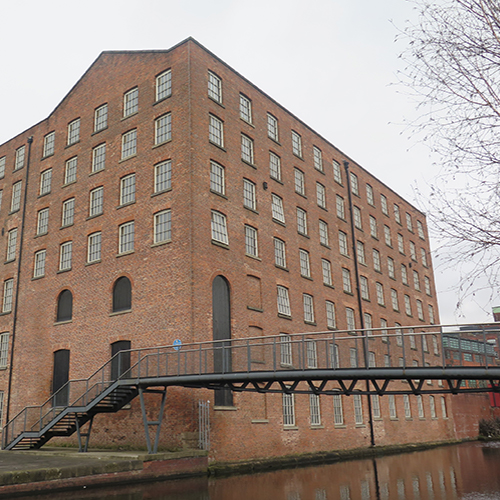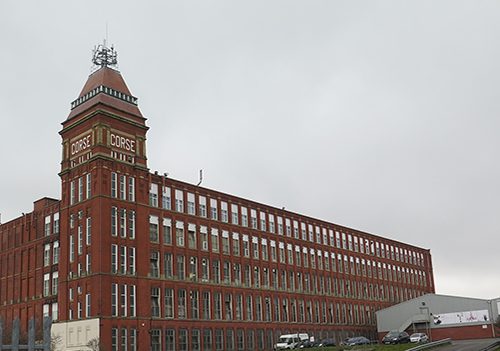Greater Manchester’s Textile Mills Survey Review
The textile industry formed a crucial element of England’s economic base from the medieval period onwards, focused initially on the production of woollens. The processing of flax to produce linen had become an important branch of the textile industry by the end of the 17th century, with silk and then cotton becoming prevalent during the following century. Whichever raw material was used, spinning the fibres and weaving the yarn was carried out in a domestic setting. Rows of domestic workshops were built in increasing numbers, typically with hand-powered machinery on the top floor and living accommodation beneath. There are numerous fine examples of these artisans’ workshops surviving across Greater Manchester, with characteristic ‘loom shop’ windows on the upper floors.

The mechanisation of spinning and weaving in the later 18th and 19th centuries led to the introduction of the factory-based system, and the appearance of textile mills in the landscape. The earliest mills were depended on waterwheels to power the machinery, but the successful application of steam engines to drive machinery in the 1780s removed the necessity for textile mills to have a riverside location. This enabled Manchester to become a powerhouse of the factory-based cotton industry by the late 18th century, and unique new townscapes of tall, closely packed, steam-powered mills developed across parts of the city and in the rapidly expanding towns surrounding Manchester. Particularly fine examples of early steam-powered mills survive in Manchester along the Rochdale Canal as it passes through Ancoats, and along Cambridge Street.
New approaches to structural engineering enabled the size of textile mills to steadily increase during the course of the 19th and early 20th centuries as mechanical innovations led to the development of much larger machinery and more powerful steam engines to drive them. Important groups of these later mills survive in several towns across Greater Manchester, with particularly impressive examples dominating the skyline in Oldham. Once described as ‘the most prodigious mill town in Lancashire’, Oldham had become the cotton-spinning capital of the world by the end of the 19th century, and consumed one third of the cotton used in British textile mills.

The commanding architecture of textile mills has become a key characteristic of industrial towns across north-west England, and is one of the iconic symbols of the Greater Manchester’s rich industrial heritage. The surviving mills impart a powerful sense of place, and epitomise the successful introduction of the factory-based system that transformed the region into one of the world’s leading manufacturing centres. The rapid and terminal decline of the textile industry during the second half of the 20th century, however, created challenges for many textile mills that struggled to find new uses, and a large number were demolished.
In response to the widespread loss of these monumental buildings during the second half of the 20th century, the former Royal Commission on the Historical Monuments of England (RCHME) instigated a large-scale mill survey across Greater Manchester during the 1980s. This concluded that 972 mills survived intact and identified the most important examples, which resulted in the statutory designation of 90 mills as listed buildings.
An urgent need to review the data from the 1980s survey after more than 25 years of attrition and loss of these historic buildings was acknowledged in 2016, when GMAAS secured funding from Historic England to review the stock condition of the textile mills across the county. This survey was carried out by the University of Salford in 2016-17, and concluded that almost 45% of the historic textile mills recorded across Greater Manchester in the 1980s had been demolished, leaving a total of 540 sites where at least some buildings survived. More than half of the surviving mills were found to be in good overall condition and made a positive contribution to the local economy and the historic landscape, although at least one-fifth were considered to be facing a stark future, with the remainder vulnerable to inappropriate change or complete loss (https://historicengland.org.uk/images-books/publications/historic-textile-mills-greater-manchester/greater-manchester-textile-mills-survey-exec-summary/).
The dataset generated from this study provided an invaluable baseline to inform and support spatial and economic planning frameworks. Building on the results obtained from the survey, for instance, Oldham Council commissioned ELG Planning in 2018 to develop a positive strategy for the sustainable future of the remaining textile mill stock across the borough. This culminated in the draft Oldham Mills Strategy in 2020, which identifies those mills that are no longer viable and may have potential for alternative development such as residential, employment or mixed use, and those mills that should be targeted for initiatives that ensure their sustainable future (https://www.elgplanning.co.uk/consultation/oldhammills). GMAAS holds the records created during the initial textile mills survey in the 1980s and the review 2016-17, together with a series of technical reports generated from the latter survey.